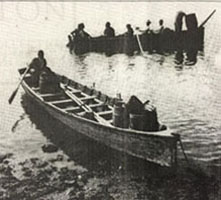


Recently, IfYouWereMayor.com had the opportunity to meet with a small group of residents from Charleston’s Wagner Terrace neighborhood. They were gathered for an introduction to the “Mosquito Fleet,” the elite group of African-American fisherman who supplied most of Charleston’s downtown area with seasonal catch for more than 100 years.
During the mid-twentieth century, the Ports Authority built a passenger terminal that closed off their boat basin, sending the remnants of the fishing fleet to a small waterfront parcel at the foot of Laurens Street where, unfortunately, their livelihood of the past would slowly erode to little more than a pasttime. As development occurred in the area, fewer of the surviving fleet members would spend time on the waterfront. Eventually the Ports Authority fenced off the parcel and cut off access to any of the remaining descendants of this noble group.
In the early 1990s, a small handful of local adults, including Rob Dunlap, Edwin Gardner, and Rose Mitchell, decided that a diverse group of 5th-8th grade children – half coming from the private school Porter-Gaud and half coming from a predominantly black downtown middle school – could benefit from the unique experience afforded by boatbuilding. They figured that the hands-on activity would make every child equal as novices, regardless of their background, and that the African-American children in the group could re-connect to the water that had so defined the region’s history. With the generous support of Detyens Shipyard, the group spent almost 2 years building two beefy 34’ long rowing “gigs” that had similarities to some of the vessels used by the original Mosquito Fleet. The New Charleston Mosquito Fleet was born.
Many in the Wagner Terrace group had never heard of the “Mosquito Fleet” and were astonished to learn about the rich history of these “watermen.” One member of the group, a school teacher, had shared this story with her students. She noted that the children were totally surprised to learn of this legacy. Everyone was excited to learn of the newly formed Lowcountry Maritime Society and how its boatbuilding project in several of the local schools was a continuation of the New Charleston Mosquito Fleet. You can check out their boatbuilding programs here.
How much of the area’s richness and artistry can be traced to the skills and artistry of slaves and free blacks? The sweetgrass basket (here and here) is relatively well known, and the area’s jazz legacy continues through the efforts of such groups as Jazz Artists of Charleston (here). It has long been known that may of the area’s food traditions have roots in Africa. The recent Nat Fuller dinner underscored the legacy of African-American (and immigrant) chefs and this article from Charleston Magazine highlights others from this rich, storied tradition.
Virtually every historic home in the city owes its craftsmanship to black masons, painters, and carpenters. The distinctive ironwork of Charleston is highlighted through the work of the renowned blacksmith Philip Simmons and the foundation that continues his legacy (here). The American College of the Building Arts (here) is dedicated to continuing the artistry of the building trades in Charleston and throughout the world. While its staff and students are largely white, one hopes that connections to the African-American craftsmen are not lost as this Charleston-based institution continues to grow.
What can this mean to us today? A recent article in The Guardian newspaper, entitled “What Will Happen When Harlem Becomes White?” (here), speculates about the impact of gentrification on black culture and history. Black residents in Harlem are of two minds: “At the heart of Harlem’s gentrification are black residents old and new, many of whom are thankful for the new amenities and nighttime options. A very particular brand of black pride is being curated, sold and embraced – a move that is at the same time celebrating and threatening the very core of a dynamic black heritage and culture.”
It is important for all of Charlestonians to understand and appreciate the extent to which black culture has created the authentic culture of the city. Everyone must realize that Charleston’s real culture is not just a set of bankable commodities, but represents a unique set of vital relationships and connections that should be continued and cultivated. Community life among blacks has often been outside the home, existing in gatherings at parks, churches, and on front stoops and porches. In New York the crackdown on casual outdoor gatherings during the 1990s eroded a key element of the informal black community life and the result may contribute to some of the tensions that exist between police and these communities of color.
With the advent of gentrification in Charleston will it be possible to foster relationships that can preserve the black community as a facet of the city’s vitality? An authentic future for Charleston really depends on it.